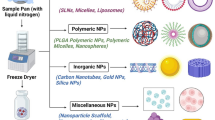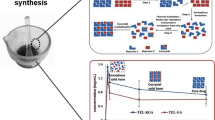Abstract
Microspheres loaded by 2-aminopyrimidine (2-AP) and based on cellulose derivatives as polymeric matrices: ethylcellulose (EC) and cellulose acetate butyrate (CAB), were prepared by double emulsion solvent evaporation method (w/o/w). The main objective of this research is to conceptualize the fabrication of new formulations with high encapsulation efficiency and a large range of size for a controlled drug release of a water-soluble drug. The effects of the process variables, namely, nature of the matrix, stirring speed, surfactant nature and concentration on the mean particle size and distribution, drug loaded, encapsulation efficiency and drug release were investigated. The microspheres were characterized by SEM, optical microscopy, FT-IR spectroscopy and the size and size distribution (δ) were determined. SEM images showed spherical and porous microspheres with different structures. We have obtained systems with large ranges of size (d32, 45–219 µm with EC; d32, 37–160 µm with CAB using Polyvinyl alcohol (PVA) as emulsifier; and d32, 294–779 µm with Tween 80) by modifying the process parameters. Furthermore, the mean diameter d32 and the dispersion can be controlled particularly by stirring speed of emulsion and the emulsifier nature and concentration. The drug entrapment and encapsulation efficiency were improved by controlling certain factors, especially by using PVA as a stabilizer in the continuous phase, by increasing PVA concentration (2% PVA) and when using EC as a matrix. The drug release was established in simulated gastric medium at pH 1.2 and 37 °C by UV–Vis analysis to estimate the drug content. The kinetics results revealed that the drug release is governed by the diffusion mechanism and the release rate can be adjusted by varying the encapsulation factors that have a significant effect on the particle size and size distribution.
Graphical abstract






Similar content being viewed by others
References
Gulcan M, Doğru U, Öztürk G, Levent A, Akbaş E (2014) Fluorescence properties and electrochemical behavior of some Schiff bases derived from N-amino-pyrimidine. J Fluoresc. https://doi.org/10.1007/s10895-013-1303-x
Kumar S, Deep A, Narasimhan B (2015) Pyrimidine derivatives as potential agents acting on central nervous system. Cent Nerv Syst Agents Med Chem. https://doi.org/10.2174/1871524914666140923130138
Shi M, Wang L, Zhang L, Wang K et al (2021) Synthesis and evaluation of antitumor activities of 4-selenopyrimidine derivatives. Nucleosides Nucleotides Nucleic Acids. https://doi.org/10.1080/15257770.2020.1833342
Ghannoum M, Abu Elteen K, El-Rayyes NR (1989) Antimicrobial activity of some 2-aminopyrimidines. Microbios 60:23–33
Lindsey EA, Worthington RJ, Alcaraz C, Melander C (2012) 2-Aminopyrimidine as a novel scaffold for biofilm modulation. Org Biomol Chem. https://doi.org/10.1039/c2ob06871k
Ozkan G, Franco P, De Marco I, Xiao J et al (2019) A review of microencapsulation methods for food antioxidants: principles, advantages, drawbacks and applications. Food Chem. https://doi.org/10.1016/j.foodchem.2018.07.205
Amasya G, Badilli U, Aksu B, Tarimci N (2016) Quality by design case study 1: design of 5-fluorouracil loaded lipid nanoparticles by the W/O/W double emulsion-solvent evaporation method. Eur J Pharm Sci. https://doi.org/10.1016/j.ejps.2016.01.003
Iqbal M, Zafar N, Fessi H, Elaissari A (2015) Double emulsion solvent evaporation techniques used for drug encapsulation. Int J Pharm. https://doi.org/10.1016/j.ijpharm.2015.10.057
Giri TK, Choudhary C, Ajazuddin AA, Badwaik H et al (2013) Prospects of pharmaceuticals and biopharmaceuticals loaded microparticles prepared by double emulsion technique for controlled delivery. Saudi Pharm J. https://doi.org/10.1016/j.jsps.2012.05.009
Chong-Cerda R, Levin L, Castro-Ríos R, Hernández-Luna CE et al (2020) Nanoencapsulated laccases obtained by double-emulsion technique. Effects on enzyme activity pH-dependence and stability. Catalysts. https://doi.org/10.3390/catal10091085
Laffleur F, Krouská J, Tkacz J, Pekař M, Aghai F, Netsomboon K (2018) Buccal adhesive films with moisturizer- the next level for dry mouth syndrome. Int J Pharm. https://doi.org/10.1016/j.ijpharm.2018.08.032
Cazorla-Luna R, Notario-Pérez F, Martín-Illana A, Bedoya LM et al (2020) Development and in vitro/ex vivo characterization of vaginal mucoadhesive bilayer films based on ethylcellulose and biopolymers for vaginal sustained release of Tenofovir. Biomacromol. https://doi.org/10.1021/acs.biomac.0c00249
Notario-Pérez F, Cazorla-Luna R, Martín-Illana A, Galante J et al (2020) Design, fabrication and characterisation of drug-loaded vaginal films: state-of-the-art. J Control Release. https://doi.org/10.1016/j.jconrel.2020.08.032
Jabar A, Madni A, Bashir S, Tahir N et al (2021) Statistically optimized pentazocine loaded microsphere for the sustained delivery application: Formulation and characterization. PLoS ONE. https://doi.org/10.1371/journal.pone.-0250876
Chen W, Palazzo A, Hennink WE, Kok RJ (2017) Effect of particle size on drug loading and release kinetics of gefitinib-loaded PLGA microspheres. Mol Pharm. https://doi.org/10.1021/acs.molpharmaceut.6b00896
Kumar A, Chanda S, Agarwal S, Singh M et al (2021) Formulation and evaluation of gastro-retentive Tinidazole loaded floating microsphere for sustained release. Mater Today Proc. https://doi.org/10.1016/j.matpr.2021.05.616
Mouffok M, Mesli A, Abdelmalek I, Gontier E (2016) Effect of formulation parameters on encapsulation efficiency and release behavior of p-aminobenzoic acid-loaded ethylcellulose microspheres. J Serb Chem Soc. https://doi.org/10.2298/JSC160308068M
Du L, Liu S, Hao G, Zhang L et al (2021) Preparation and release profiles in vitro/vivo of galantamine pamoate loaded poly (lactideco-glycolide) (PLGA) microspheres. Front Pharmacol. https://doi.org/10.3389/fphar.2020.619327
Pang L, Gao Z, Feng H, Wang S (2019) Cellulose based materials for controlled release formulations of agrochemicals: a review of modifications and applications. J Control Release. https://doi.org/10.1016/j.jconrel.2019.11.004
Zhou J, Walker J, Ackermann R, Olsen K et al (2020) Effect of manufacturing variables and raw materials on the composition-equivalent PLGA microspheres for 1 month controlled release of leuprolide. Mol Pharm. https://doi.org/10.1021/acs.molpharmaceut.9b01188
Hwisa NT, Katakam P, Chandu B, Adiki SK (2013) Solvent evaporation techniques as promising advancement in microencapsulation. Vedic Res Int Biolog Medicin Chem. https://doi.org/10.14259/bmc.v1i1.29
Thakare M, Israel B, Garner S, Ahmed H et al (2017) Nonionic surfactant structure on the drug release, formulation and physical properties of ethylcellulose microspheres. J Pharm Dev Technol. https://doi.org/10.1080/10837450.2016.1221431
Hinze JO (1955) Fundamentals of the hydrodynamic mechanism of splitting in dispersion processes. AIChE J. https://doi.org/10.1002/aic.690010303
Jégat C, Taverdet JL (2000) Stirring speed influence study on the microencapsulation process and on the drug release from microcapsules. Polym Bull. https://doi.org/10.1007/s002890050612
Alexandridou S, Kiparissides C (1994) Production of oil-containing polyterephthalamide microcapsules by interfacial polymerization. An experimental investigation of the effect of process variables on the microcapsule size distribution. J Microencapsul. https://doi.org/10.3109/02652049409051110
Kaczmarski K, Bellot JC (2003) Effect of particle-size distribution and particle porosity changes on mass-transfer kinetics. Acta Chromatogr 13(13):22–37
El Bahri Z, Taverdet J-L (2007) Elaboration and characterisation of microparticles loaded by pesticide model. Powder Technol. https://doi.org/10.1016/j.powtec.2006.10.036
Subedi G, Shrestha AK, Shakya S (2016) Study of effect of different factors in formulation of micro and nanospheres with solvent evaporation technique. Open Pharm Sci J. https://doi.org/10.2174/1874844901603010182
Merdoud A, Mouffok M, Mesli A, Chafi N et al (2020) In vitro release study of 2-aminobenzothiazole from microspheres as drug carriers. J Serb Chem Soc. https://doi.org/10.2298/JSC190326132M
Vankova N, Tcholakova S, Denkov N-D, Ivanov I-B et al (2007) Emulsification in turbulent flow 1. Mean and maximum drop diameters in inertial and viscous regimes. J Colloid Interface Sci. https://doi.org/10.1016/j.jcis.2007.03.059
Silverstein RM, Bassler GC, Morill TC (1981) Spectrometric identification of organic compounds, 4th edn. Wiley, New-York
Higuchi T (1963) Mechanism of sustained-action medication. Theoretical analysis of rate of release of solid drugs dispersed in solid matrices. J Pharm Sci. https://doi.org/10.1002/jps.2600521210
Korsmeyer RW, Peppas NA (1984) Solute and penetrant diffusion in swellable polymers III. Drug release from glassy P(HEMA-co-NVP) copolymers. J Control Release. https://doi.org/10.1016/0168-3659(84)90001-4
Dash S, Murthy PN, Nath L, Chowdhury P (2010) Kinetic modeling on drug release from controlled drug delivery systems. Acta Pol Pharm 67(3):217–223
Crank J (1973) The mathematics of diffusion, 2nd edn. Brunel University Uxbridge, London
Albert A, Sergent E (1971) The determination of ionization constants. Chapman and Hall, Great Britain
Author information
Authors and Affiliations
Corresponding author
Rights and permissions
About this article
Cite this article
Mouffok, M., Abdelmalek, I., Mesli, A. et al. Investigation of Factors Affecting Particle Size Distribution and Sustained Release of a Water-Soluble Drug from Cellulose Derivatives Microspheres. Chemistry Africa 6, 163–173 (2023). https://doi.org/10.1007/s42250-022-00323-6
Received:
Accepted:
Published:
Issue Date:
DOI: https://doi.org/10.1007/s42250-022-00323-6




